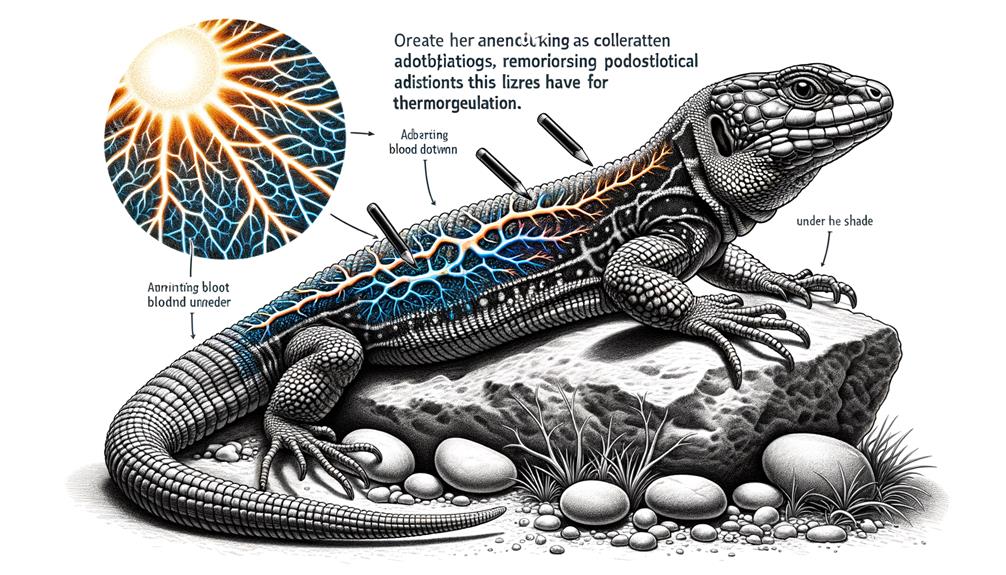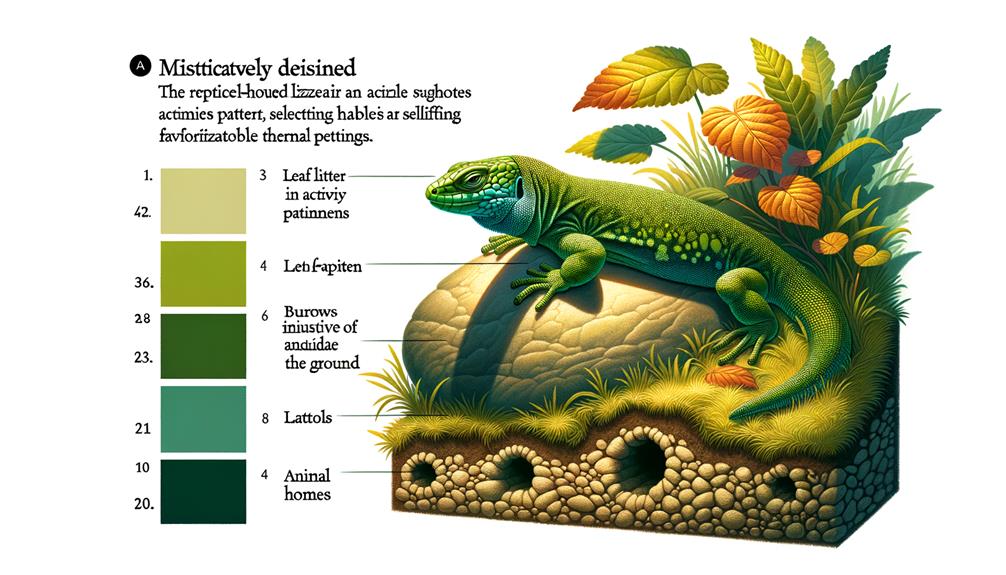Reptiles have developed various strategies to regulate their body temperature. They soak up the sun's warmth and seek shade or cooler spots to avoid overheating. By adjusting their posture and selecting favorable microhabitats, they efficiently manage heat absorption and loss. Physiologically, reptiles can modify their heart rate, shunt blood, and even change skin color to control their body temperature. Adaptations like hibernation help them survive extreme conditions. However, climate change poses a significant threat by disrupting these mechanisms and habitats. Understanding how these changes impact reptilian survival is crucial.
Key Takeaways
Reptiles use various strategies to regulate their body temperature. One approach is to make behavioral adjustments, such as basking in the sun or seeking shade. They also have physiological adaptations, like modulating heart rate and skin pigmentation, to control their internal thermal states.
Reptiles choose specific microhabitats, like burrows or sun-exposed rocks, to maintain optimal temperatures. As ectothermic animals, they use behavior to stay within their critical thermal maximum and minimum limits. However, rising temperatures due to climate change can disrupt their thermoregulation, affecting their survival and reproductive success.
Behavioral Adjustments
Reptiles have developed a range of behavioral adjustments to regulate their body temperature and maintain ideal thermal conditions. By employing these thermoregulatory behaviors, they expertly navigate their thermal ecology. For example, basking directly under the sun allows reptiles to elevate their body temperature to perfect levels. On the other hand, when temperatures rise too high, they seek shade or cooler microclimates to prevent overheating.
One fascinating aspect of reptile thermoregulation is communal basking. By clustering together, multiple reptiles can efficiently absorb heat, optimizing their thermal intake. This collective approach highlights the intricate social dynamics within reptile thermal ecology.
Postural adjustments also play a crucial role. Reptiles can maximize surface area exposure to heat sources by flattening their bodies, increasing heat absorption. Conversely, elevating their bodies reduces contact with hot surfaces, helping to dissipate excess heat.
Reptiles also exhibit behaviors like burrowing and hiding in vegetation to find microclimates with favorable thermal conditions. These strategies demonstrate their sophisticated ability to fine-tune their body temperature, ensuring survival across diverse and sometimes extreme habitats.
Physiological Adaptations

Exploring physiological adaptations reveals that reptiles have developed specialized mechanisms to precisely regulate their internal temperatures amidst fluctuating environmental conditions. These processes are critical in maintaining body temperature within ideal ranges, enabling reptiles to thrive in diverse habitats.
Reptiles employ various thermoregulatory strategies, such as adjusting their heart rate and blood flow to manage heat distribution. Their metabolic rates can also vary, facilitating efficient energy use depending on the thermal environment.
The table below highlights key physiological adaptations in reptiles:
| Adaptation | Function | Impact on Thermoregulation |
|---|---|---|
| Heart Rate Modulation | Regulates heat distribution | Maintains stable internal temperatures |
| Blood Shunting | Directs blood flow to essential organs | Enhances thermal stability |
| Metabolic Rate Adjustment | Alters energy expenditure | Conserves energy in cooler conditions |
| Skin Pigmentation Changes | Affects heat absorption | Optimizes body temperature control |
| Hormonal Regulation | Influences metabolic processes | Balances internal thermal states |
Understanding these adaptations showcases the sophistication of reptilian thermal biology. By utilizing these mechanisms, reptiles can efficiently navigate and adapt to their often-challenging environments. This intricate interplay of physiological processes highlights the resilience and adaptability of reptiles, allowing them to survive and even thrive in a wide range of temperatures.
These remarkable physiological adaptations enable reptiles to conserve energy, maintain thermal stability, and optimize body temperature control. As a result, they are able to survive and flourish in diverse habitats, from scorching deserts to icy tundras. The intricate dance of physiological processes in reptiles is a testament to their remarkable ability to adapt to their environment.
Microhabitat Selection

Microhabitat selection is a crucial aspect of thermoregulation in reptiles. Desert lizards, for example, avoid extreme heat by burrowing underground or seeking shade under shrubs during peak sunlight. This behavior helps them maintain a stable body temperature and align their activity patterns with cooler periods.
Aquatic turtles move between shallow, sun-warmed waters and deeper, cooler areas in lakes or ponds to regulate their body temperature efficiently. This allows them to perform essential tasks like foraging and mating without thermal stress.
Snakes, such as the northern copperhead, coil on sun-exposed rocks or logs to absorb heat, then retreat to shaded areas to prevent overheating. By selecting specific microhabitats, they can maintain optimal body temperature and sustain activity patterns that maximize survival and reproductive success.
Arboreal lizards, like the anole, adjust their position on tree trunks or branches throughout the day. By selecting various thermal microenvironments, they can fine-tune their body temperature, enhancing their ability to thrive in fluctuating conditions. These behaviors highlight the critical role of microhabitat selection in reptilian thermoregulation.
Thermal Tolerances

Reptiles have adapted to diverse and sometimes extreme environmental conditions in remarkable ways. Their thermal tolerances vary greatly among species and habitats, with critical thermal maximum and minimum temperatures differing significantly. This variability is influenced by species-specific adaptations, such as aestivation and hibernation, which enable some reptiles to endure extreme temperatures.
The geographic distribution of reptile species is often determined by their thermal tolerances, with different species thriving in warmer or cooler climates. Ectothermic reptiles, which rely on external heat sources, use behavioral thermoregulation to maintain body temperatures within their ideal range. By doing so, they optimize their physiological performance, as maintaining ideal body temperatures is vital for activities like foraging, digestion, and reproduction.
Climate Change Impacts

Climate change poses a significant threat to reptile populations by disrupting their habitats and thermal regulation mechanisms. As global temperatures rise, the delicate balance of temperature ranges that reptiles rely on for survival is increasingly at risk. Being ectothermic, reptiles depend on external heat sources to regulate their body temperature, a process crucial for their survival.
Reptiles have developed various thermoregulatory strategies, such as basking in the sun or seeking shade, which are finely tuned to specific environmental conditions. However, climate change impacts, like increased frequency of extreme weather events and shifts in seasonal patterns, compromise these strategies. For example, higher temperatures may narrow the window of ideal thermal conditions, forcing reptiles into suboptimal habitats or activity patterns. This can lead to reduced reproductive success, altered behavior, and even increased mortality rates.
Furthermore, altered temperature ranges can affect the availability of prey and the incidence of diseases, further stressing reptile populations. In some cases, species might migrate to new areas with suitable climates, but this often leads to habitat fragmentation and competition with native species. As a result, climate change not only affects individual reptiles but also disrupts entire ecosystems, posing a significant threat to biodiversity.
Frequently Asked Questions
What Are the Thermoregulatory Strategies in Reptiles?
Reptiles have developed various thermoregulatory strategies to survive in their environments. They use behavioral adaptations like basking in the sun and seeking shade to regulate their body temperature. Physiological changes, such as adjustments to their metabolism, circulation, and evaporative cooling, also play a crucial role in thermoregulation. These strategies are vital for reptiles' survival, habitat selection, and evolutionary success.
What Are the 4 Mechanisms for Temperature Regulation?
The four mechanisms for temperature regulation are behavioral thermoregulation, physiological adaptations, evaporative cooling, and blood flow adjustments. These strategies are truly fascinating because they enable reptiles to thrive in varying environments, optimizing their physiological processes and overall well-being.
How Do Reptiles Control Their Body Temperature?
Reptiles regulate their body temperature using a combination of behavioral and physiological strategies. They bask in the sun or seek shade to control their body heat, and also adjust their metabolic rate and use evaporative cooling to maintain a comfortable temperature. These adaptations ensure they stay within their preferred temperature range.
What Are the Methods of Thermoregulation in Animals?
Animals have developed various strategies to regulate their body temperature, including behavioral adaptations, physiological changes, and anatomical features. These methods enable them to maintain thermal balance. For instance, they use basking, shivering, altering blood flow, and adjusting metabolic rates to achieve this balance.



